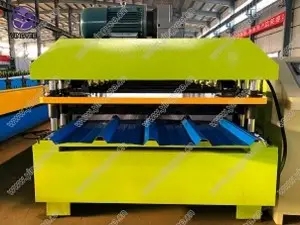
Understanding Wall Angle Roll Forming Machines
In the realm of metal fabrication and construction, the efficiency and precision of manufacturing processes play a critical role in determining the success of various projects. One key technology that has emerged as indispensable in this sector is the wall angle roll forming machine. This innovative equipment is primarily used to manufacture wall angles, which are essential components in the construction of buildings, frames, and various structural systems.
What is a Wall Angle?
A wall angle is an extruded metal profile that forms a 90-degree angle typically used for creating frames for drywall, suspended ceilings, and decorative structures. It serves to provide a strong, supportive framework while facilitating the installation of panels or other materials. The need for durable, lightweight, and easy-to-install components in construction has led to an increased demand for wall angles, making the roll forming machine a vital piece of machinery in this industry.
The Function of Wall Angle Roll Forming Machines
Wall angle roll forming machines are designed to transform flat metal sheets into the desired wall angle profile with high precision and efficiency. The process involves feeding a flat strip of metal through a series of rollers that gradually shape the material into the final angle configuration. This method allows for the production of uniform profiles, essential for maintaining structural integrity and aesthetic appeal.
The roll forming process is known for its ability to produce long sections of profiles continuously, which can significantly reduce manufacturing time and waste. Unlike traditional fabrication methods, roll forming minimizes off-cuts, ensuring that the raw material is utilized to its fullest potential. This efficiency not only cuts down costs but also supports sustainable practices within the industry.
Key Components of Wall Angle Roll Forming Machines
A typical wall angle roll forming machine comprises several essential components
1. Feeding System The initial stage where flat metal sheets are fed into the machine. Precision in this system is critical to ensure that the sheets are aligned correctly for subsequent forming processes.

2. Roll Forming Stations These are the heart of the machine, featuring multiple sets of rollers that progressively shape the metal. Each station is strategically designed to bend and form the metal at specific angles until the desired wall angle profile is achieved.
3. Cut-off System Once the profile has been formed, it needs to be cut to the required lengths. The cut-off system can be configured to perform batch cuts or continuous cuts based on manufacturing needs.
4. Control System Modern wall angle roll forming machines come equipped with advanced control technology, allowing operators to adjust parameters such as speed, temperature, and pressure. This flexibility enables precise tuning for various materials and thicknesses.
5. Safety Features Given the nature of the machinery, incorporating safety mechanisms is crucial. Emergency stops, safety guards, and automatic shut-off systems are standard to protect operators and maintain a secure working environment.
Applications of Wall Angles
Wall angles produced by roll forming machines find extensive applications in various sectors, including commercial buildings, residential complexes, and industrial facilities. They play a pivotal role in creating light-gauge metal framing systems, which are praised for their strength, durability, and resistance to environmental factors.
Furthermore, wall angles are essential in the construction of suspended ceiling systems, providing a structural base to support ceiling tiles and panels. They also serve decorative purposes in architectural applications, allowing for creative license in design and structure.
Conclusion
As the construction industry continues to evolve, the importance of efficient, precise manufacturing technologies like wall angle roll forming machines cannot be overstated. These machines significantly enhance production capabilities, reduce waste, and contribute to the overall quality of building components. Given the ongoing demand for innovative and sustainable construction practices, investing in high-quality wall angle roll forming machinery is a strategic move for manufacturers seeking to enhance their operational efficiency and product offerings.